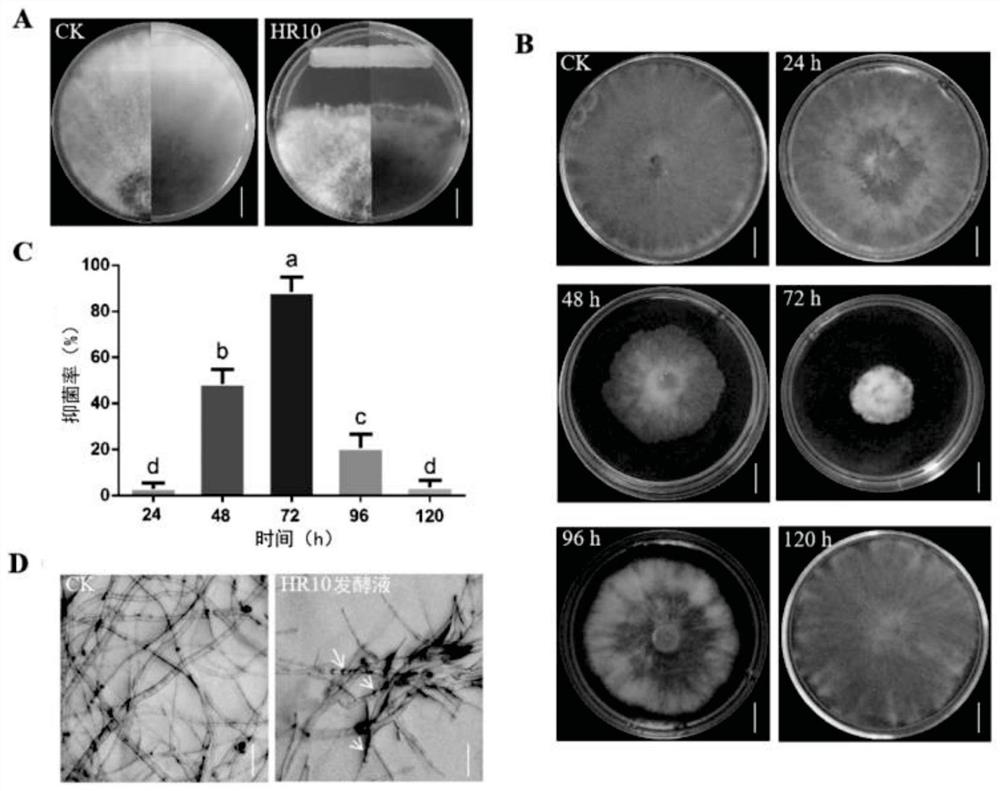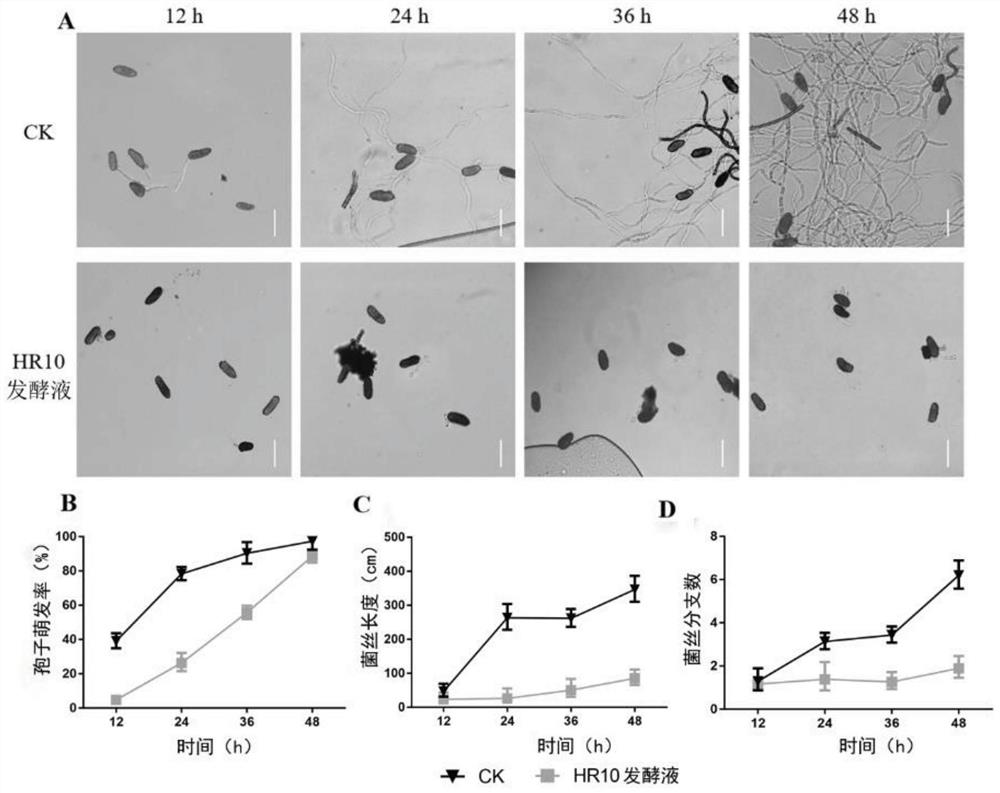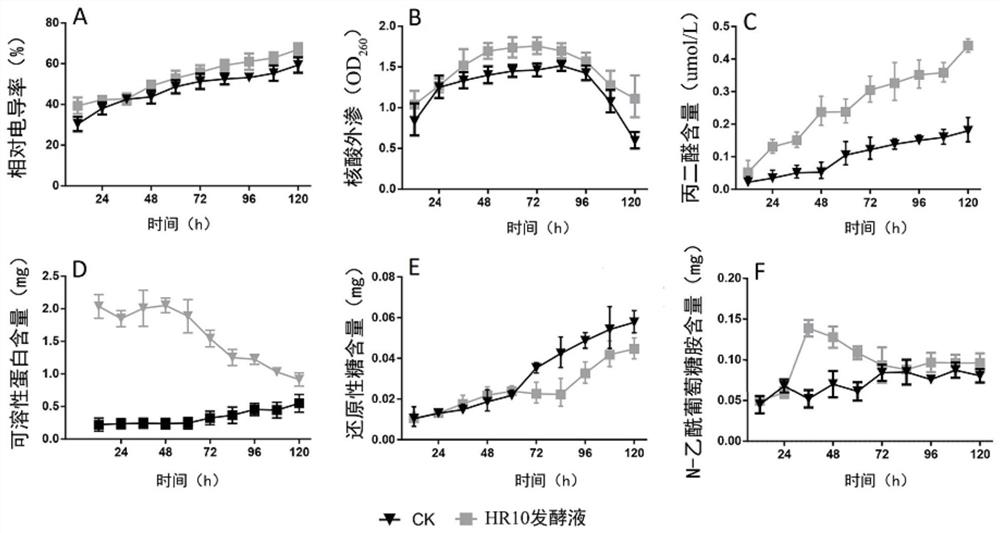New application of bacillus pumilus HR10 in prevention and treatment of forest diseases
A technology of Bacillus pumilus and bacteria agent, applied in the field of biological control, can solve the problems of unseen strain application reports, achieve environmental friendly side effects, and reduce the effect of use
- Summary
- Abstract
- Description
- Claims
- Application Information
AI Technical Summary
Problems solved by technology
Method used
Image
Examples
Embodiment 1
[0026] Example 1: Determination of the antagonistic effect of Bacillus pumilus HR10 on S. sapinea mycelial growth and spore germination
[0027] Inoculate B.pumilusHR10 on Luria-Bertani (LB) liquid medium, culture at 28°C with shaking at 200r / min until logarithmic growth phase; inoculate S.sapinea on potato dextrose agar (PDA) medium, at 25°C , cultivated in the dark for 5 days for later use.
[0028] 1. Determination of the antagonistic effect of B. pumilus HR10 on the growth of S. sapinea mycelium
[0029] S. sapinea and B. pumilus HR10 were cultured on PDA medium for 5 days, and the size of the inhibition zone was observed. The specific method is as follows:
[0030] B.pumilus HR10 preserved at low temperature was streak cultured in LB plate medium (recipe: 10g / L sodium chloride + 10g / L tryptone + 5g / L yeast extract powder + 15g / L agar) and placed at 28°C Cultivate in the dark in an incubator for 24 hours, and use a sterile inoculation loop to pick a single colony of the ...
Embodiment 2
[0035] Example 2: Determination of the influence of HR10 bacterial strain on S. sapinea cell membrane permeability and cell content
[0036] The growth of pathogenic bacteria is inseparable from the physiological metabolism of cells, and the normal physiological metabolism of cells depends on the integrity of cell membranes and the normal synthesis of cell contents. Relative conductivity, nucleic acid extravasation and malondialdehyde (MDA) content are important indicators to measure cell membrane permeability. Higher relative conductivity means more leakage of electrolytes in the cell membrane and more severe cell damage. In order to investigate whether the HR10 strain inhibits the growth of S. sapinea hyphae and spore germination, whether it achieves the purpose of antagonism by affecting the physiological metabolism of pathogenic bacteria cells, it is necessary to investigate the effect of HR10 strain on S. sapinea cell membrane permeability and cell content. Impact.
[0...
Embodiment 3
[0042] Embodiment 3: Investigate the influence of HR10 bacterial strain on S. sapinea infecting pine needles
[0043] Centrifuge the bacillus pumilus HR10 cultured for 24 hours at 10,000 r / min for 10 minutes, collect the bacteria, wash with sterile water and dilute to 1×10 8 After cfu / mL, spray 2mL evenly on the pine tip of Masson pine, use sterile water as the blank control, spray S. sapinea spore suspension 3 days later, and after another 3 days, cut the needles and leaves of the pine tip for fixation, disinfection and drying , gold spraying and other treatments, the growth status of S. sapinea was observed with an environmental scanning electron microscope ((Quanta 200, USA)).
[0044] Under normal circumstances, S. sapinea hyphae can directly invade through the stomata on needles ( Figure 4 A), the morphology of the spores is plump and can normally germinate mycelium ( Figure 4 B); and a large number of HR10 strains can be seen in and around the stomata of needles spra...
PUM
 Login to View More
Login to View More Abstract
Description
Claims
Application Information
 Login to View More
Login to View More - R&D
- Intellectual Property
- Life Sciences
- Materials
- Tech Scout
- Unparalleled Data Quality
- Higher Quality Content
- 60% Fewer Hallucinations
Browse by: Latest US Patents, China's latest patents, Technical Efficacy Thesaurus, Application Domain, Technology Topic, Popular Technical Reports.
© 2025 PatSnap. All rights reserved.Legal|Privacy policy|Modern Slavery Act Transparency Statement|Sitemap|About US| Contact US: help@patsnap.com



